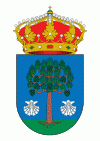Cambre
 |
According to the 2010 census, the municipality of Cambre includes 23,621 inhabitants spread over its 12 parishes, which occupy 41 square kilometres. The parishes are those of O Temple, Cambre, Sigrás, Anceis, San Lorenzo, Cela, Andeiro, Santa María de Vigo, Bribes, Brexo-Lema, Cecebre and Pravio. It shares municipal boundaries with the neighbouring municipalities of Culleredo, Carral and Oleiros.
The town of Cambre has many sites of interest. Among them are:
The Church of Our Lady Mary of Cambre (Spanish: Iglesia de Santa María de Cambre, Galician: Igrexa de Santa María de Cambre), built around the 12th century; an archaeological museum with a permanent exhibition of the remains of a Roman bathroom and latrine; and the house of Galician writer Wenceslao Fernández Flórez (1885–1964).
The town is located on the Way of St. James (Camino de Santiago), though on the English Way (Camino inglés), used mainly by pilgrims coming from England and Ireland via ship to A Coruña or Ferrol, and from there on foot to Santiago de Compostela.
Cambre's name is considered to derive from "Calambre" or "Calamber", according to different sources. It is first mentioned during the construction of the Church of Santa María (12th century). The name was very possibly given to the area by Knights Templar, a Christian order created in the aftermath of the First Crusade of 1096. The Order ceased to exist two centuries later, but after they had built a fortress near the town's centre which has since ceased to exist. One of Cambre's parishes is called Temple in their honour.
However, there are other theories which give a different origin to Cambre's name. Carré Aldao suggests its name derives from "Cambria", which sounds relatively similar to Cymru (Wales). If this were true, it might suggest an early invasion of the region by Welsh vikings several centuries ago, though it may well be a semilegendary hypothesis derived from a romantic view of history to link the Celtic people with those of Galicia. Nevertheless, this theory might be supported by the fact that when the Romans arrived to the Northwestern region of the Iberian Peninsula (present day Galicia and Northern Portugal), they named the area Galicia, as they recognized the ethnic group that populated the region as different from the rest of the peninsula. The Latin derived terms Galicia or Galegos, derive from Gales, which in the majority of languages evolved from Latin translates to Wales.
Map - Cambre
Map
Country - Spain
 |
 |
| Flag of Spain | |
Anatomically modern humans first arrived in the Iberian Peninsula around 42,000 years ago. The ancient Iberian and Celtic tribes, along with other pre-Roman peoples, dwelled the territory maintaining contacts with foreign Mediterranean cultures. The Roman conquest and colonization of the peninsula (Hispania) ensued, bringing the Romanization of the population. Receding of Western Roman imperial authority ushered in the migration of different non-Roman peoples from Central and Northern Europe with the Visigoths as the dominant power in the peninsula by the fifth century. In the early eighth century, most of the peninsula was conquered by the Umayyad Caliphate, and during early Islamic rule, Al-Andalus became a dominant peninsular power centered in Córdoba. Several Christian kingdoms emerged in Northern Iberia, chief among them León, Castile, Aragon, Portugal, and Navarre made an intermittent southward military expansion, known as Reconquista, repelling the Islamic rule in Iberia, which culminated with the Christian seizure of the Emirate of Granada in 1492. Jews and Muslims were forced to choose between conversion to Catholicism or expulsion, and eventually the converts were expelled through different royal decrees.
Currency / Language
| ISO | Currency | Symbol | Significant figures |
|---|---|---|---|
| EUR | Euro | € | 2 |
| ISO | Language |
|---|---|
| EU | Basque language |
| CA | Catalan language |
| GL | Galician language |
| OC | Occitan language |
| ES | Spanish language |















